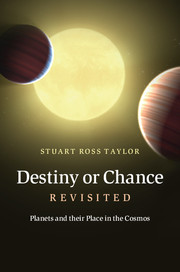2 - The universe
Published online by Cambridge University Press: 05 October 2012
Summary
“The true constitution of the universe–the most important and admirable problem that there is” [1].
AN EXPANDING VIEW
In order to obtain some perspective on the place of planets in the scheme of things, it is useful to contemplate the scale of the universe, as we perceive it at present. Everything in the universe is very isolated. The nearest star to us is Proxima Centauri, a red dwarf and the faintest member of a triple star system of which Alpha Centauri is the brightest. This star is familiar to dwellers in the southern hemisphere, as it forms one of the Pointers to the Southern Cross. Light from this nearest star takes 4.2 years to reach us. Although Proxima Centauri is the nearest star at present, the dwarf star Ross 248 will succeed to the title in about 33,000 Earth years. Because of the slow relative movements of the stars, our familiar constellations, such as Orion the Hunter and his companion, the Great Dog, will be rearranged and replaced by other groupings in the future. Edmund Halley (1656–1742), of comet fame, seems to have been one of the first to realize this, by observing that the positions of many stars in the early eighteenth century differed from those recorded in the catalogue of Hipparchus in the second century BCE.
- Type
- Chapter
- Information
- Destiny or Chance RevisitedPlanets and their Place in the Cosmos, pp. 26 - 58Publisher: Cambridge University PressPrint publication year: 2012

